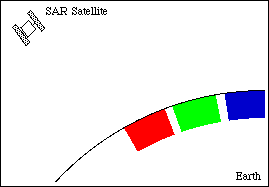
Synthetic Aperture Radar satellites take a picture of the ground by "shining" radar light toward the Earth. In the resulting image, the brightness corresponds to the amount of light returning to the satellite. In this respect, aside from a different type of light (microwave radiation instead of visible light), SAR satellites are just like our eyes, cameras, and ordinary optical satellites.
But while our eyes, cameras, and optical satellites only measure the angle of the returning light, and ignore the time the light returns; a SAR satellite only measures the time the light returns to the satellite, and ignores the angle. Because the time it takes for the light to make a round trip is directly related to the distance from the satellite, SAR sees the Earth in an equal-distance fashion.
This difference creates a number of challenges in interpreting SAR images. See slant and ground range for a list.
The following animation shows a SAR satellite imaging a single strip of the Earth's surface.
In the animation, the satellite sends a pulse (usually in the form of a "chirp") of microwave radiation towards the ground. This pulse bounces, or echos, off each patch of ground. The echo from each patch of ground then returns to the satellite, and the satellite records this echo. Later (not shown ;-) we at ASF use this recored echo to re-construct the patches of the ground.

Most SAR satellites image five to ten thousand patches of ground with a single pulse; here, we only show three. For clarity, these patches of ground have been colored red, green, and blue; but SAR images are usually only monochromatic (black and white). Also, most SAR satellites have several pulses on the way to the ground at once.
SAR satellites usually send more than a thousand pulses toward the ground each second. However, since they are moving at around 7 kilometers (4 miles) per second, each pulse is 4 to 10 meters (12 to 30 feet) apart.
Back to interferometry main page
Last Updated: September 1, 1998
If you have any questions, please feel free to email olawlor@acm.org